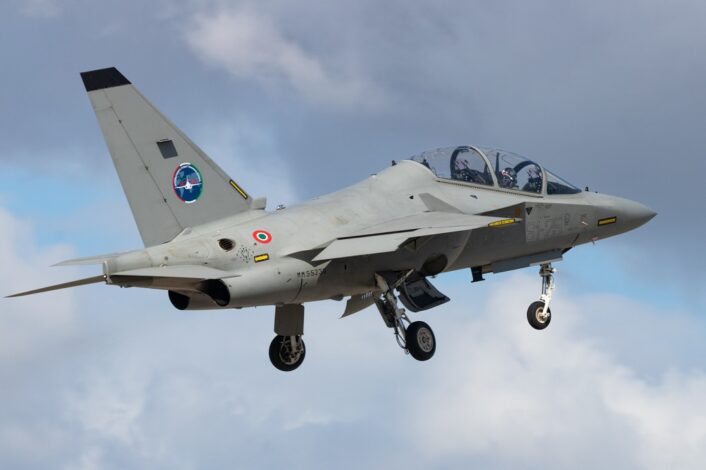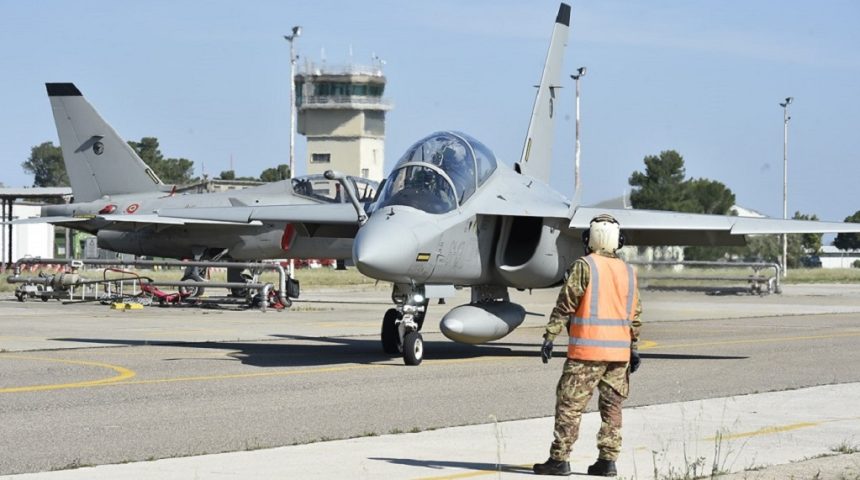The two pilots are the first of twelve that will undergo Lead In Fighter Training at Decimomannu air base.
The first two Royal Air Force pilots trained in Italy at the International Flight Training School at Decimomannu air base reached the milestone of the first solo flight on the T-346 Master. The two pilots graduated earlier this year from the United Kingdom Military Flying Training System’s (UKMFTS) basic flight training on the Texan T1 and are now training at the Sardinian air base following the technical arrangement signed with the Italian Air Force earlier this year.
In fact, on May 13, 2023, the Royal Air Force has joined IFTS with an agreement, signed during the AeroSpace Power Conference held in Rome, for the Phase IV training of student pilots and instructor pilots. A total of 12 RAF pilots are expected to train over a three-year period in Italy, with the first two completing the training course in May 2024.
The initiative is also part of the broader NATO Flight Training Europe (NFTE) High Visibility Project, a multinational initiative launched in 2020 to link up and coordinate military flying training resources across member states. The UK joined NFTE at the NATO Defence Ministers’ meeting in Brussels on Oct. 11, 2023, when the Secretary of State for Defence Grant Shapps signed an amendment to an existing Memorandum of Understanding.
“Access to alternate flying training systems across Europe, which NFTE membership gives us, not only enables us to address periodic fluctuations in demand but also delivers the flexibility for us to increase our support to NATO,” said Air Commodore Sharrocks, Head of UK Military Flying Training. “Crucially this will deliver greater resilience to the RAF frontline, UK defence, and all of our NATO partners. It is essential that we work together to get the very best out of the assets we have.”
Two students have become the first RAF pilots to fly solo at the International Flight Training School hosted by the @ItalianAirForce in Sardinia, training alongside colleagues from other @NATO air arms. 🇮🇹 🇬🇧#StrongerTogether #NATO
More 👉 https://t.co/XsCt30YeuF pic.twitter.com/oHEm26j5Kf
— Royal Air Force (@RoyalAirForce) November 15, 2023
Among the reasons for the RAF to join IFTS and NFTE is the backlog in the UKMFTS fast jet pilot training due to aircraft and instructors shortages. British pilots are also being trained in the Euro-NATO Joint Jet Pilot Training at Sheppard Air Force Base in the USA. Becoming a participant in NFTE will balance out demand across NATO, increase efficiency of training systems, and deliver costs savings, said the RAF. Membership will also bolster opportunities for NATO partners to train in the UK when spare capacity allows.
According to the ItAF and RAF Chiefs, training will be crucial also in light of the preparation of the two air forces to the 6th generation aircraft. In fact, Gen. Luca Goretti and Air Chief Marshal Sir Mike Wigston, both Tornado pilots trained at the Tri-national Tornado Training Establishment (TTTE) at RAF Cottesmore, agreed that they need to look ahead on how to build an international common training to be ready when the new generation aircraft is delivered in 2035.
“Deci at the moment is getting the pilots ready for the GCAP or Eurofighter”, said Wigston, “but what’s exciting to me about Deci is the principles which have been applied, and it is a glimpse of the future, in terms of AR (Augmented Reality), Synthetic Training, platforms being used. And it might not be Deci, might not be the systems and aircraft there, but the principles that the Italian Air Force, Leonardo and CAE: that points to how we will internationally do pilot training in the future.”
At the moment, Canada, UK, Germany, Austria, Saudi Arabia, Qatar, Singapore and Japan are the nations which have already elected IFTS for their Phase IV/LIFT training, while many more are about to join the program.
The Phase IV training of the Italian Air Force pilots is based on two pillars: the T-346A advanced training aircraft and its integrated training system, which allow students to conduct real and synthetic training missions in a joint manner, increasing the training value. The T-346 and the LIFT training has recently officially relocated to Decimomannu Air Base in Sardinia, where a new larger Italian Air Force/Leonardo International Flight Training School Campus was built.

The pilots are trained under the widely adopted “train as you fight” concept, to better prepare them for operational units. Today’s fighter pilots need to have first order management skills as right now the superiority against adversaries is obtained in the information domain, the fusion of the info from multiple domains and the reaction time. The modern LIFT training highly reflects these needs.
The syllabus developed for the Phase 4 heavily exploits the ground training segment of the M-346 to build these capabilities, with the live flights being the last step of the training and amounting to roughly 50% of the training events. The simulator training is so realistic that can be counted as real flight hours, without losing training effectiveness.
The entire Phase IV course includes a total of approximately 150 simulator and real flight training sessions during the nine months of training, flown in all weather conditions, during day and night, with the aid of Helmet Mounted Displays and Night Vision Systems. During this phase, students also have the opportunity to train in real-life shooting scenarios in dedicated training areas in Sardinia, giving them the ability to immediately test in the field the skills acquired.
Decimomannu is, in fact, home to the AWTI (Air Weapons Training Installation), a fully integrated training installation with air-to-air and air-to-ground ranges as well as an EW (Electronic Warfare) range. The school’s move there gives more ease of access to the ranges and training areas at any time, increasing the training efficiency without the need for periodic deployments to other locations to access the ranges.









